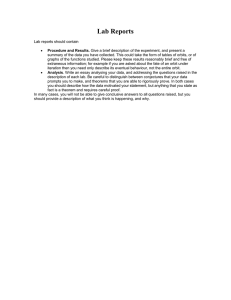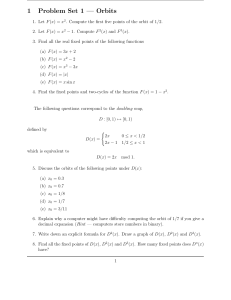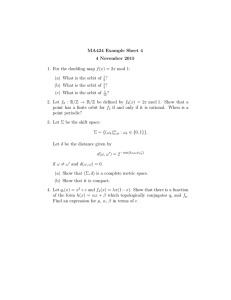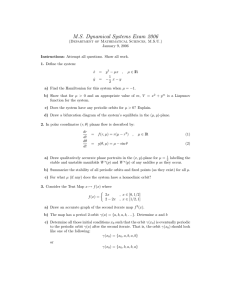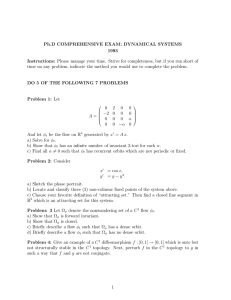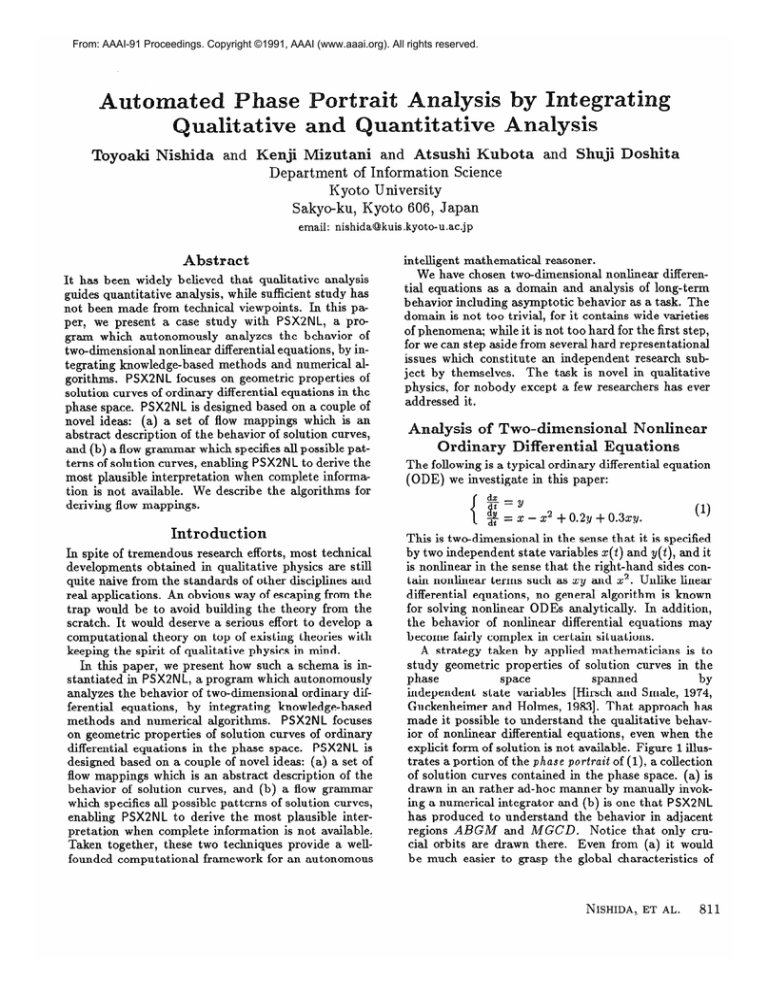
From: AAAI-91 Proceedings. Copyright ©1991, AAAI (www.aaai.org). All rights reserved.
Toyoaki Nishida
and Kenji
Department of Information Science
Kyoto University
Sakyo-ku, Kyoto 606, Japan
email:
nishida@kuis.kyoto-u.ac.jp
Abstract
It has been widely believed that qualitative analysis
guides quantitative analysis, while sufficient study has
not been made from technical viewpoints.
In this paper, we present a case study with PSX2NL, a program which autonomously
analyzes the behavior of
two-dimensional nonlinear differential equations, by integrating knowledge-based
methods and numerical algorithms.
PSX2NL focuses on geometric properties of
solution curves of ordinary differential equations in the
phase space. PSX2NL is designed based on a couple of
novel ideas: (a) a set of flow mappings which is an
abstract description of the behavior of solution curves,
and (b) a flow grammar which specifies all possible patterns of solution curves, enabling PSX2NL to derive the
most plausible interpretation
when complete information is not available.
We describe the algorithms for
deriving flow mappings.
Introduction
In spite of tremendous research efforts, most technical
developments obtained in qualitative physics are still
quite naive from the standards of other disciplines and
real applications.
An obvious way of escaping from the
trap would be to avoid building the theory from the
scratch. It would deserve a serious effort to develop a
computational
theory on top of existing theories with
keeping the spirit of qualitative physics in mind.
In this paper, we present how such a schema is instantiated in PSXlLNL, a program which autonomously
analyzes the behavior of two-dimensional
ordinary difby integrating
knowledge-based
ferential equations,
methods and numerical algorithms.
PSX2NL focuses
on geometric properties of solution curves of ordinary
differential equations in the phase space. PSX2NL is
designed based on a couple of novel ideas: (a) a set of
flow mappings which is an abstract description of the
behavior of solution curves, and (b) a flow grammar
which specifies all possible patterns of solution curves,
enabling PSX2 N L to derive the most plausible interpretation when complete information is not available,
Taken together, these two techniques provide a wellfounded computational
framework for an autonomous
intelligent mathematical
reasoner.
We have chosen two-dimensional
nonlinear difFerential equations as a domain and analysis of long-term
behavior including asymptotic behavior as a task. The
domain is not too trivial, for it contains wide varieties
of phenomena; while it is not too hard for the first step,
for we can step aside from several hard representational
issues which constitute an independent research subThe task is novel in qualitative
ject by themselves.
physics, for nobody except a few researchers has ever
addressed it.
Analysis of Two-dimensional
Nonlinear
ifferentid Equations
Ordinary
The following is a typical ordinary differential equation
(ODE) we investigate in this paper:
dx
ifz
= : - x2 + 0 . 2y + 0 .3xy
dt =
.
0)
This is two-dimensional
in the sense that it is specified
by two independent state variables x(t) and y(t), and it
is nonlinear in the sense that the right-hand sides cont ain nonlinear terms such as xy and x2. Unlike linear
differential equations, no general algorithm is known
for solving nonlinear ODES analytically.
In addition,
the behavior of nonlinear differential equations may
become fairly complex in certain situations.
A strategy taken by applied mathematicians
is to
study geometric properties of solution curves in the
phase
space
spanned
bY
independent
state variables [Hirsch and Smale, 1974,
Guckenheimer and Holmes, 19831. That approach has
made it possible to understand the qualitative behavior of nonlinear differential equations, even when the
explicit form of solution is not available. Figure 1 illustrates a portion of the phase portrait of (l), a collection
of solution curves contained in the phase space. (a) is
drawn in an rather ad-hoc manner by manually invoking a numerical integrator and (b) is one that PSX2NL
has produced to understand the behavior in adjacent
regions ABGM and MGCD.
Notice that only crucial orbits are drawn there.
Even from (a) it would
be much easier to grasp the global characteristics
of
NISHIDA, ET AL.
811
(a) manuzdly drawn using a numerical
.---.
__-_----.
-2
_---__------1
--.9-L..
---
- -.--
3
-
--
(b) produced
integrator
- ----_
--2
by PSX’LNL for local analysis
____ _-_. -*
35
I
-2;
~~
Arrow-heads
Figure
1: The Phase Portrait
behavior such as: y decreases as time passes, there exists some solutions which approaches to an equilibrium
statex=l,y=Oast-+--oo,andsoon.
The collection of solution curves is also called a flow,
for it introduces a mapping which maps a given point in
the phase space into another as a function of t. Each
solution curve, called an orbit, represents a solution
under some initial condition.
Theoretically,
an orbit is a directed curve such that
its tangent vector conforms to the vector field specified
by a given ODE at each point in the phase space. A
fized point is a special orbit consisting of a single point
at which g = 3
= 0. A fixed point corresponds
to an equilibrium state which will not evolve forever.
Fixed points are further classified into sinks, sources,
saddles, and some other peculiar subcategories according to how orbits behave in their neighborhood.
If the
solution of a given ODE is unique as is often the case,
orbits never cross with themselves or other orbits. An
orbit must be cyclic if it intersects with itself.
Under many circumstances,
it is crucial to understand the long-term behavior of a given ODE. In structurally stable two-dimensional
ODES, orbits may diverge or approach a fixed point or a cyclic orbit when
t -+ foe.
An orbit is called an attracting orbit when
all orbits in some neighborhood
approach it arbitrarily after a long run. Similarly, a repelling orbit is an
orbit which all orbits in some neighborhood
approach
as t + -co.
Conversely, when an orbit 01 approaches
orbit 02 as t --) 00 (-00)~ we call 02 the asymptotic destination (origin) of 01. In this paper, we study the behavior of qualitatively coherent bundles of orbits rather
than individual orbits.
It is possible to obtain an approximate
picture of
812
QUALITATIVE ANALYSIS
and some symbols
are added by hand.
for (1)
an orbit by using a numerical integration
algorithm
such as the Runge-Kutta
algorithm,
as was done for
examples in this paper. However, numerical methods
support only a small portion of the entire process of understanding the behavior, as pointed out in [Yip, 19881.
It is necessary to plan numerical simulation and interpret the result. In order for a program to carry out
the entire process without much external assistance,
the program has to possess sufficient knowledge about
nonlinear differential equations.
In order to integrate
numerical and knowledge-based methods, one must address several questions concerning (a) representation
of
orbits, (b) algorithm for generating the representation,
and (c) algorithm for reasoning about global behavior based on the representation.
The central concern
of this paper is the second and to demonstrate
how
qualitative and quantitative
analysis are integrated to
achieve the goal. Before describing that, we present an
overview of our solution to these three questions in the
next section.
Outline
of our Solution
PSX2NL is a program which autonomously
analyzes
the behavior of two-dimensional
ODES. PSX2NL takes
as input the specification of an ODE such as (1) and
a region of the phase space to analyze.
As output
PSX’LNL produces (a) a list of possible asymptotic origins and destinations and (b) a set of flow mappings, an
abstract description of the behavior of the given ODE
in the given region. In this section, we briefly describe
flow mappings and their use in reasoning about longterm behavior, and then we present the overall picture
of the algorithms for deriving flow mappings.
Flow Mappings
Representation
as Abstract
of the Phase
and hence,
41 0 42(FQ)
Portrait
We represent a flow as a set of flow mappings which
specifies how the flow maps points in the phase space.
For example, consider the flow in the region MGCD
shown in figure l(b). Orbits transverse to segment T Q
continuously map points on the segment to polyline
27 G H. We represent the fact as 42,2 : T Q + U G H,
where 42,2 is a label attached to the bundle of orbit
intervals between T Q and U G H. We call U G H the
destination of T Q, and T Q the or&n of U G H (with
respect to the given region).
The whole flow 42 in
is represented as a sum of sub-flows
region MGCD
corresponding to bundles of orbit intervals in MGCD,
as follows:
42 =
:TQ-+UGH
: MT + LMB~~,~
7
c~q+~,~:Y
+QU$42,4:Ii
- L4 HI~~2,5:CJ-tIC~~2,s:Dli’~JD.
42,1
(2)
Given a flow 4 and a region R, we may denote the
origin and destination of geometric object 2 with respect to R as 4-‘(z)
and 4(x), respectively.
Thus,
the flow 42 in region MGCD introduces relations such
as T = &l(L),
L = #2(T), 42(L) = H, and so on.
Note that there are some subtle cases. For example,
4T1(Q) = Y but 42(Y) = Q U; or &l(T)
is not defined in region MGCD.
In order to generate flow mappings, it is necessary
to identify characteristic
points such as Q and characteristic orbits such as orbit Q * U or T - L - H.
The role of flow mappings is twofold.
First, flow
mappings are used to reason about long-term behavior. Second, flow mappings serve as an intermediate
representation
for qualitative and quantitative
analysis to interact. Consider Van der Pol’s equation
dx
= -2x3 + 2x + 2y
g
dt = -x.
The flow illustrated
flow mappings:
in figure 2(a)
,l :A
41 =
+1,2
$1,3
&,4
(3)
is characterized
cq(R)+
: 4,‘
(R)s
: B4T1(S)
: 4?(S)
p
by
(4
41,s :
41,s :
$1,7 :
&,8
for region ABEF,
:
and
cj52:CDFQ-+QEC
for region ECDF.
By combining
h(FQ)
+1(6si?P)
Q)
(5)
the two,
=
92(F)
c
=
h(Q) 41(P)
$;‘(P)Q
c
FQ,
(6)
(7)
c FQ.
(8)
(8) entails that there exists an attracting
bundle of
orbits containing at least one limit cycle transverse to
41 0 h(FQ) = h(Q) b42(F).
Seefigure2(b)Notice that qualitative and quantitative analysis are
integrated in the lines of reasoning described above.
The main thread is concerned with topological aspects
of bundle of orbit intervals and hence it is qualitative,
while the basic facts are obtained by quantitative analysis.
The global analyzer incorporated
in PSX2NL recognizes attracting
or repelling bundles of orbits containing
a limit cycle by chaining flow mappings in
turn and looking for such patterns of argumentation
The domains of attraction
and
as described above.
repelling are also determined in this process. The algorithm for the global analyzer was originally developed for PSX2PWL, the predecessor of PSX2NL, and is
described in [Nishida and Doshita, 19901.
Outline of the Algorithms
Flow Mappings
for
PSX2NL uses multiple strategies.
The most opportunistic strategy called the algorithm T depends on
the assumption that complete information required for
generating flow mappings can be obtained by availThe most pesable quantitative
problem solvers.
simistic strategy called the algorithm I does not depend on such assumptions, instead it uses approximate
methods to derive plausible interpretation.
There are
many intermediate
levels between the two depending
on availability of information.
The Algorith
In order to generate a set of flow mappings, it is necessary to know the location and the type of fixed points
in the given region and to classify the boundary of the
region into a set of maximally
continuous boundary
segments so that orbits transverse to each of these segments may be coherent in the sense that the behavior
of these orbits in the region is qualitatively equal. Useful clues for classifying the behavior are obtained by
recognizing every point of contact on the boundary at
which the orbit is tangent to the boundary and lies in
the same side of the boundary immediately before and
after contact.
A point of contact is called a concave
node if the orbit passing on it lies inside the region immediately before and after contact. Otherwise a point
of contact is called a convex node. Note that a convex node of a region is a concave node of its adjacent
region, and vice versa. Thus, Q is a convex node of region ABGM in figure l(b), while it is a concave node
of region MGCD.
The most straightforward
algorithm for generating a
set of flow mappings for a given region R is this:
(step Tl)
identify fixed points and their type in R;
NISHIDA,
ET
AL.
813
(b) more elaborated
%1,6
,i
ii+g-dJ
i
a
-1
1
; +y .,,,K’(P)
------------------------~
p-*‘~
g
Figure
I
t1
I
II
I
:
2: The Phase Portrait
(step T2)
divide the given region into a set of subregions (called cells) (. . . Ci . . .) so that at
most one fixed point is contained in each
cell;
(step T3)
for each cell Ci , repeat
the following:
identify points of contact and determine their type;
a for each concave node, trace the orbit passing on it forward and backward until the traced orbit meets the
boundary
again, or it comes appropriately near one of the known fixed
points, or it is judged that the orbit approaches a known or unknown cyclic orbit; if the traced orbit is almost cyclic,
split Ci by a line crossing the detected
almost-cyclic
orbit, and recursively apply (step T3) to the resulting cells;
l
o for each saddle node in Cd, trace the orbits in stable and unstable manifolds,l
similarly;
e generate
(step
T4)
flow mappings
for C;;
flow mappings
for the region
g enerate
by aggregating analysis obtained for each
cell.
In order to pursue the steps of the algorithm
T,
PSX2NL has to solve varieties of mathematical
prob‘As
for
[Guckenheimer
8 14
the
definitions,
and Holmes, 19831.
QUALITATIVE ANALYSIS
C
see
for
example
picture
of (a)
s ..
B
for Van der Pol’s Equation
(3)
lems. For example, PSX’LNL has to solve simultaneous
nonlinear equations g = c?L
di = 0, to obtain the location of fixed points. Thus, for (1) PSX’LNL has to solve:
Y = 0 A 3c - x2 + 0.2~ + 0.32~ = 0. In order to identify
points of contact of a given cell, PSX2NL has to solve
an (often nonlinear) equation with a single variable.
PSX2NL uses a simple mathematical
problem solver including an equation solver and a numerical integrator
using the Runge-Kutta
algorithm.
When encountered
with a more complex problem, PSX2NL calls Macsyma.
However, there do exist many problems which cannot
be solved, even by a powerful mathematical
tool like
Macsyma or by a numerical method. If Macsyma ends
up in failure, PSX’LNL will switch to a less precise but
more robust algorithm such as the algorithm 1.
As for ODE (l), all information
is available with
a simple equation solver except finding the location
of fixed points.
Fortunately,
Macsyma can solve the
remaining problem.
Thus, PSX2NL performs the following steps to analyze the behavior of (1) in region
ABCD in figure l(b): first, PSX’LNL recognizes that
the region contains two fixed points: a saddle at (0,O)
and a source at (1,O) (designated as X and Y, respectively); PSX2NL then divides the region into two cells
ABGM and MGCD, each containing one fixed point
(note that PSX2NL splits the region in the middle point
between the two fixed points, but this is not essential); PSX’LNL correctly recognizes four convex nodes
for cell ABGM,
and three concave nodes and three
convex nodes for cell MGCD; PSX2NL traces orbits in
stable and unstable manifolds of the fixed point X and
marks points F, S, R and M as important landmarks at
which these orbits meet with the boundary; similarly,
by tracing forward and backward the orbits passing on
concave nodes J, L, and Q of region MGCD, PSX2NL
identifies landmarks I, K, H, T, and 27, and it also
concludes that the orbit passing on Q comes from the
source Y; finally, PSX2NL produces a set of flow mappings for ABCD by aggregating the flow mappings for
each cell.
Note that what is obtained in the above may not be
a logical (or mathematical)
conclusion derived from a
given ODE in the sense that some of the rules used
in the derivation are heuristic ones based on numerFor example, PSX2N L concludes
ical approximation.
that the asymptotic
destination of an orbit is a sink
if the traced orbit enters a predetermined
small neighThe quality and reliability of
borhood of the sink.
interpretation
will be improved by introducing more
mathematical
knowledge and increasing the accuracy
of numerical computation,
but it may not totally solve
the problem.
The Algorithm
L
The algorithm I takes care of the situation in which
no information is available about the location of fixed
points and points of contact due to difficulties of mathematical problems involved.
The basic idea to overcome the difficulty is to enumerate all possible patterns
of flow in turn, compare each pattern with observation,
and pick out one which achieves the best match.
To
represent a pattern of flow, we use a flow pattern consisting of a set of flow mappings and description of geometric objects referred to by flow mappings. We have
introduced a flow grammar to describe the set of all
possible flow patterns one may encounter. The reader
is referred to [Nishida and Doshita, 19911for details of
the flow grammar we use.
Like the algorithm T, the algorithm I takes ODE f
and region R and produces a set of flow mappings for
R as interpretation.
The algorithm is this:
(step II)
sample the flow at the boundary of R and
calculate the orientation of the flow there;
(step 12)
aggregate
the observed flow into a set
of maximal hypothetical
boundary fragments so that the orientation of flow at
each boundary fragment may be coherent;
(step 13)
assume a point of contact for each pair of
sample points such that the orientation of
the flow has flipped from inward to outward or vice versa, and mark the pair as
a delimiter of a point of contact; furthermore, infer numerically the type of each
assumed point of contact;
(step 14)
construct a partial flow pattern for R by
tracing an orbit forward and backward
from each inferred point of contact (as a
result, boundary
new landmarks);
edges may be divided by
if the traced orbit exhibits periodic behavior, split the current region into two
by a line cutting across the periodic portion of the orbit, and apply the algorithm
I recursively to resulting sub-regions;
(step 15)
enumerate flow patterns and look for one
which matches the partial flow pattern
constructed by observation;
(step 16)
if such a flow pattern is found, break the
process or go to (step 14) depending on
the computation
resource allocated; if no
flow pattern is found, repeat the whole
process by increasing precision of observation;
Generally, flow pat terns generated in earlier cycles are
simpler and hence more probable than those produced
later. Hence, we prefer flow patterns enumerated earlier. If more than one flow pattern matches in one
cycle, we prefer the one with minimal number of constituents which are not supported by observation.
What
PSXILNLCan Do and Cannot
Do
Qualitative
and quantitative
analysis are integrated
in PSX2NL as described above. In the algorithm T,
qualitative analysis determines what to compute, and
quantitative
analysis provides an answer.
In the algorithm I, qualitative analysis generates hypotheses
when complete information is not available, and quantitative analysis provides evidences for or against them.
Preliminary
implementation
of PSX2NL has been
completed
using a simple blackboard
architecture.
PSX2NL handles fixed point detection and classifica
tion, saddle manifold construction,
flow map construction, limit cycle detection, and attractor
basin detection. A bifurcation analyzer has not been implemented
yet. The search process taken by PSX’LNL is heuristic
in nature. There is no theoretical proof that PSX2NL
can hnd aU fixed points, all limit cycles, even though
we restrict the class of flows to structurally stable ones
whose flow is more regular than otherwise. Thus, the
result depends on the quality and variety of numerical algorithms and other mathematical
tools available
from PSX’LNL. Limit cycle detection by PSX2NL is not
weak as it may appear. The global analysis algorithm
employed by PSX2NL always detects the existence of
a limit cycle and identifies the asymptotic property of
the bundle of orbit intervals containing the limit cycle, as far as the phase space division by boundaries of
cells cuts across the limit cycle. In addition, PSX2NL
tries to cut across a cyclic orbit whenever it detects
symptoms.
Thus, the ability of PSX2NL should be evaluated by
experimentation.
Currently, we have found out that it
works well for several structurally
stable flows. Comprehensive evaluation is left for future.
NISHIDA, ET AL.
815
Comparison
with Related
Work
Kuipers pointed out the importance
of integration
of qualitative and quantitative
analysis and incorpe
quantitative
methods
QSIM
rated
into
We have taken
a
[Kuipers and Berleant, 19881.
quite different approach
and base the framework
on rigid mathematical
theories,
as was done in
[Abelson et al., 19891.Yip is concerned with analyzing discrete dynamical systems represented by difference equations [Yip, 19881.His approach is to develop
a framework of intelligent numerical experimentation
based on mathematical
knowledge about the domain.
Though in a similar spirit, the techniques presented in
this paper are for analyzing continuous systems and
bear quite different features from those employed by
Yip. In particular, representation
issues become more
critical for continuous systems.
Sacks reported work on analysis of two-dimensional
piecewise linear differential equations
[Sacks, 19901.
Sacks uses transition diagrams as internal representation of flow [Sacks, 19901.Unfortunately,
the expressive power of transition diagram is quite limited and in
order to reason about long-term behavior it is necessary to use a separate set of heuristic rules or introduce
a probabilistic
technique [Doyle and Sacks, 19891. In
contrast, flow mappings presented in this paper have
more expressive power, enabling to reason about longterm behavior. 2
Forbus
presented
a framework
in which modeling language
and simulation
are closely
integrated [Forbus and Falkenhainer,
19901. Giving the
framework an ability of analytical thinking as introduced in this paper will make his proposal more powerful.
Future Work
There are several short-term
problems left for future
research, other than those pointed out in the above.
Among others lots should be done for improving the efficiency of the matching algorithm for the algorithm 1.
One obvious way is to compile a set of candidates into
a discrimination net. A more long-range, and challenging issue is extension into higher-dimensional
systems.
We believe that insights obtained in two-dimensional
phase spaces would be of great conceptual, even though
not technical, help towards that goal.
20ne reviewer of this paper pointed out that there is
much overlap between our work and Elisha Sacks’ recent
work. According
to the reviewer, Sacks’ recent work was
published
in Computing
Systems in Engineering
l:2 (p.
607) 1990 and Proc. of the 29th IRRR Conference on Decision and Automation,
as well as is forthcoming
from AIJ.
Unfortunately
we were ignorant of them, for one has not
been published yet and others are not included in common
readings of AI. Detailed comparison
is left for future.
816
QUALITATIVE ANALYSIS
References
Abelson,
Harold;
Eisenberg,
Michael;
Halfant,
Matthew;
Katzenelson,
Jacob; Sacks, Elisha; Sussman, Gerald J.; Wisdom, Jack; and Yip, Kenneth
1989.Intelligence in scientific computing.
Communi-
cations of the ACM 32:546-562.
Doyle, Jon and Sacks, Elisha P. 1989.Stochastic analysis of qualitative dynamics.
In Proceedings IJCAI-
89. 1187-1192.
Forbus, Kenneth D. and Falkenhainer,
Brian 1990.
Self-explanatory
simulations:
An integration of qualitative and quantitative
knowledge.
presented at
4th International
Workshop on Qualitative Physics,
Lugano, Switzerland.
Guckenheimer,
John and Holmes,
Hirsch,
W.
Philip
1983.
Non-
Stephen
1974.
O$-
linear Oscillations, Dynamical Systems, and Bifurcations of Vector Fields. Springer-Verlag.
Morris
and Smale,
ferential Equations, Dynamical Systems, and Linear
Algebra. Academic Press.
Kuipers, B. J. and Berleant, Daniel 1988. Using incomplete quantitative
knowledge in qualitative reasoning. In Proceedings AAAI-88. 324-329.
Nishida, Toyoaki and Doshita,
Shuji 1990. PSX:
A program
that explores phase portraits
of twodimensional piecewise linear differential equations.
Memoirs of the Faculty of Engineering,
versity 52(4):311-355.
Kyoto
Uni-
Nishida, Toyoaki and Doshita, Shuji 1991. A geometric approach to total envisioning. unpublished research note.
Sacks, Elisha 1990.Automatic qualitative analysis of
dynamic systems using piecewise linear approximations. Artificial Intelligence 41:313-364.
Yip, Kenneth Man-kam 1988. Generating global behaviors using deep knowledge of local dynamics.
In
Proceedings AAAI-88. American Association for Artificial Intelligence. 280-285.

